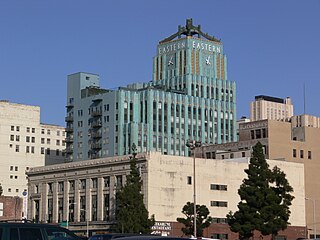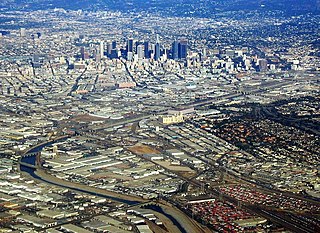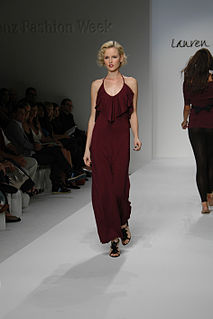
Downtown Los Angeles (DTLA) contains the central business district of Los Angeles, California. In addition, it contains a diverse residential area of some 85,000 people, and covers 5.84 sq mi (15.1 km2). A 2013 study found that the district is home to over 500,000 jobs. It is also part of Central Los Angeles.

Chinatown is a neighborhood in Downtown Los Angeles, California, that became a commercial center for Chinese and other Asian businesses in Central Los Angeles in 1938. The area includes restaurants, shops, and art galleries, but also has a residential neighborhood with a low-income, aging population of about 20,000 residents.

The Garment District, also known as the Garment Center, the Fashion District, or the Fashion Center, is a neighborhood located in the borough of Manhattan in New York City. The dense concentration of fashion-related uses give the neighborhood its name. The neighborhood, less than 1 square mile, is generally considered to lie between Fifth Avenue and Ninth Avenue, from 34th to 42nd Streets.

The Toy District is a 12-block area in eastern Downtown Los Angeles, bounded by Los Angeles Street on the west, Third and Fifth streets on the north and south and San Pedro Street on the east. It is a multilingual, multicultural area that consists of one- and two-story buildings often painted in pastel shades and is home to roughly five hundred toy- and electronics-related businesses.

The Historic Core is a district within Downtown Los Angeles includes the world's largest concentration of movie palaces, former large department stores, and office towers, all built chiefly between 1907 and 1931. Within it lie the Broadway Theater District and the Spring Street historic financial district, and in its west it overlaps with the Jewelry District and in its east with Skid Row.

Gallery Row is a neighborhood in Downtown Los Angeles designated by the City Council in 2003 to promote the concentration of art galleries along Main Street and Spring Street.

The Wholesale District or Warehouse District in Downtown Los Angeles, California, has no exact boundaries, but at present it lies along the BNSF and Union Pacific Railroad lines, which run parallel with Alameda Street and the Los Angeles River. Except for some ancillary commercial uses, its cityscape is mostly occupied by warehouses and refrigerated storage facilities. This area is known as Central City North in the Los Angeles city zoning map.
Pico Boulevard is a major Los Angeles street that runs from the Pacific Ocean at Appian Way in Santa Monica to Central Avenue in Downtown Los Angeles, California, USA. It is named after Pío Pico, the last Mexican governor of Alta California.

The Arts District is a neighborhood on the eastern edge of Downtown Los Angeles, California in the United States. The city community planning boundaries are Alameda Street on the west which blends into Little Tokyo, First Street on the north, the Los Angeles River to the east, and Violet Street on the south. Largely composed of industrial buildings dating from the early 20th century, the area has recently been revitalized, and its street scene slowly developed in the early 21st century. New art galleries have increased recognition of the area amidst the downtown, which is known for its art museums.

Skid Row is a neighborhood in Downtown Los Angeles. The area is officially known as Central City East.
Los Angeles Street, originally known as Calle de los Negros or Alley of the Black People, is a major thoroughfare in Downtown Los Angeles, California, dating back to the origins of the city as the Pueblo de Los Ángeles.

Fashion Week in Los Angeles occurs biannually. Multiple show producers hold events throughout the Greater Los Angeles area each March and October. Traditionally, the City of Los Angeles identified the third weekend of those respective months as the beginning of its Fashion Week. However, new independent event producers have been transitioning Fashion Week related activities to coincide closer in time with the LA Fashion Market Week.

Textile Center Building is a 12-story Gothic Revival and Italian Renaissance Revival architectural styled brick building located in the Los Angeles Fashion District. Designed by William Douglas Lee in the Gothic Revival style, the building opened in 1926 as a center for garment manufacturing. It has since been converted to condominiums.

El Pueblo de Los Ángeles Historical Monument, also known as Los Angeles Plaza Historic District and formerly known as El Pueblo de Los Ángeles State Historic Park, is a historic district taking in the oldest section of Los Angeles, known for many years as El Pueblo de Nuestra Señora la Reina de los Ángeles del Río de Porciúncula. The district, centered on the old plaza, was the city's center under Spanish (1781–1821), Mexican (1821–1847), and United States rule through most of the 19th century. The 44-acre park area was designated a state historic monument in 1953 and listed on the National Register of Historic Places in 1972.

San Pedro Street is a major north–south thoroughfare in Los Angeles, California, running from Little Tokyo in Downtown Los Angeles to West Rancho Dominguez. San Pedro Street was one of the earliest roadways, along with Alameda Street, between central Los Angeles and the Port of Los Angeles; much of the road's original alignment south of Jefferson Boulevard has been renamed Avalon Boulevard.
The Flower District of Downtown Los Angeles is a six block floral marketplace, consisting of nearly 200 wholesale flower dealers, located within the LA Fashion District. What started almost 100 years ago as a small flower mart near Santa Monica, California, has grown into the United States' largest wholesale flower district in its current downtown location. The Market is open very early in the morning, Monday - Saturday, and closes in the early afternoon. Every commercially available cut flower can be purchased there.
The California Mart, also known as California Market Center, are three high-rise buildings in Los Angeles, California, USA.
The Los Angeles Downtown Industrial District (LADID) is manufacturing and wholesale district of downtown Los Angeles, California, that was established as a property-based business improvement district (BID) in 1998 by the Central City East Association (CCEA). The district spans 46 blocks, covers 600 properties, and is the historic home of seafood, produce, flowers, and a variety of products daily shipped in and out of Los Angeles by air, rail, and sea. The LADID hosts the Los Angeles Wholesale Produce Market, the second largest produce market in the United States.

Row DTLA is a historic urban commercial district located in Downtown Los Angeles, at the confluence of Fashion District, Skid Row, and the Arts District. The 30-acre (12 ha) district repurposed a historic complex called Alameda Square. ROW DTLA is a mixed use development, including 100 retail stores, restaurants, and 1,300,000 square feet (120,000 m2) of commercial workspace.


















